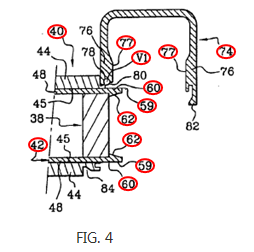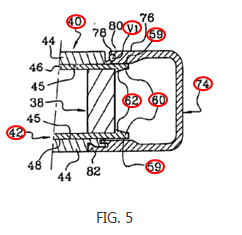Resources
Jun 22,2020
Newsletter n° 5 Case: PT | Technical feature that is a hybrid of both structural and functional limitations is not a functional feature in principle
On March 27, 2019, the Intellectual Property Tribunal of the Supreme People’s Court of China (“appeal tribunal”) maintained in Valeo Systemes d’essuyage v. Xiamen Lu Ka Si Car Accessories Ltd., Xiamen Fuke Car Accessories Ltd., et al. the patent infringement judgment handed down by the Shanghai Intellectual Property Court (“first instance court”).
The appeal tribunal held that if a technical feature defines or implies a specific structure (or a step, a composition, a condition, a correlation thereof or the like) of an invention solution, the technical feature is not a functional feature in principle, even though it also defines a function (or effect) that it can achieve. This case was selected as one of the Intellectual Property Tribunal’s guiding cases in 2019.
Fact:
Valeo Systemes d’essuyage (“Valeo”) accused Xiamen Lu Ka Si Car Accessories Ltd., Xiamen Fuke Car Accessories Ltd., et al. (“Accused Infringer”) of infringing its Chinese invention patent No. 200610160549.2 (“subject patent”) before the first instance court. The plaintiff requested that the court prioritize its finding on patent infringement and cessation of infringement, leaving other matters including calculation of damages to be adjudicated at a later date.
The subject patent refers to a wiper connector (42) for a motor vehicle intended to pivotally connect a wiper arm (22) with a shell-like component (40) of a wiper blade (24). The connector has a pair of elastic lug-like locking elements (60) with nose-like free ends (62) for locking the arm as shown in FIG. 1 below. A cap-shaped safety fastener (74) rotatable around an axis (V1) is provided with inner surfaces (77) extending along outer surfaces (59) of the elements (60) of the connector when the fastener is in its close position as shown in FIG. 5 below, thereby preventing the locking elements (60) from outward deforming and locking the connector.



Claim 1 of the subject patent recites the disputed technical feature, which reads “in its close position, said safety fastener extends facing said locking element, for preventing said locking element from elastically deforming and locking said connector”. This feature includes a first segment “in its close position, said safety fastener extends facing said locking element” and a second segment “for preventing said locking element from elastically deforming and locking said connector”.
The first instance court identified that the focus of dispute lies in whether the disputed technical feature is a functional feature and held that the disputed technical feature is a functional feature.
Appeal tribunal’s holding:
Although neither party raised objection to the finding of the first instance court that the disputed technical feature is a functional feature, the appeal tribunal expatiated on this matter:
1. If a technical feature defines or implies a specific structure (or a step, a composition, a condition, a correlation thereof or the like) of an invention solution, the technical feature is, in principle, not a functional feature as defined by the Interpretation II of the Supreme People's Court on Several Issues Concerning the Application of Law in the Trial of Disputes over Infringement of Patent Rights (2016), even though it also defines a function or effect that it can achieve.
2. The first segment of the disputed feature not only defines the orientation limitation of the fastener and the locking elements, but also implies the structure limitation “said safety fastener extends facing said locking element”. After reading the specification and its appended drawings of the subject patent, those skilled in the art would understand that the structure limitation can achieve the function of preventing and locking in the second segment when distances between extending portions of the fastener and outer surfaces of the locking elements are small enough. The disputed technical feature defines both “a specific orientation and structure limitation” and the “function of such orientation and structure limitation”. Only by taking into account both aspects (orientation/structure + function), would a person skilled in the art determine the specific contents of the orientation and structure limitation for achieving the function. In a nutshell, the disputed technical feature is essentially a technical orientation or structure feature rather than a functional feature.
Comment:
The Supreme People’s Court of China defines functional feature in Article 8 of “Interpretation II of the Supreme People's Court on Several Issues Concerning the Application of Law in the Trial of Disputes over Infringement of Patent Rights (2016)” as follows:
“Functional features refer to technical features defined by their functions or effects in the innovation-creation with respect to structures, compositions, steps, conditions, relationships thereof or the like, unless those skilled in the art, only by reading the claim, can directly and clearly determine the specific embodiments that achieve the functions or effects.
Compared with technical features that are described in a patent specification and its appended drawings and are necessary to achieve the function or effect mentioned in the preceding paragraph, if corresponding technical features of accused infringing technical solutions apply substantially the same means to perform the same functions and achieve the same effects, and if the corresponding technical features can be envisaged by those skilled in the art without inventive efforts upon occurrence of accused infringing acts, the People’s Court shall find that the corresponding technical features are identical or equivalent to the functional features.”
According to this article, once a technical feature in a patent claim is deemed as a functional feature in a patent infringement suit, the protection scope of such claim may be drastically narrowed because the claimed feature will be further limited by the technical features (disclosed in the specification and appended drawings of the patent and being necessary for performing the function of the claimed feature) and their equivalents. Thus, whether the claimed technical feature is functional is a crucial matter because it could have direct bearing on the outcome of the infringement lawsuit.
In absence of explicit provisions in current laws and judicial interpretations, courts’ practice varies in respect of ascertaining the nature of a technical feature that is a hybrid of both structural and functional limitations. To solve this conundrum, the Intellectual Property Tribunal set the below parameters:
1. If technical features in patent claims are hybrid of structures (or compositions, steps, conditions, correlations thereof or the like) and their functions (or effects), such technical features shall be presumed not to be a functional feature in principle; and
2. The aforesaid hybrid technical features shall not be deemed as a functional feature, provided that those skilled in the art, by reading the specification and its appended drawings of the patents and taking into account the structures and their functions, would clearly determine specific contents of the structures for performing the functions.
The Intellectual Property Tribunal’s new holding is expected to help establish a unified jurisprudence on the ascertaining of functional feature in patent infringement lawsuits in China.
Contributed by: Huasheng Bai
